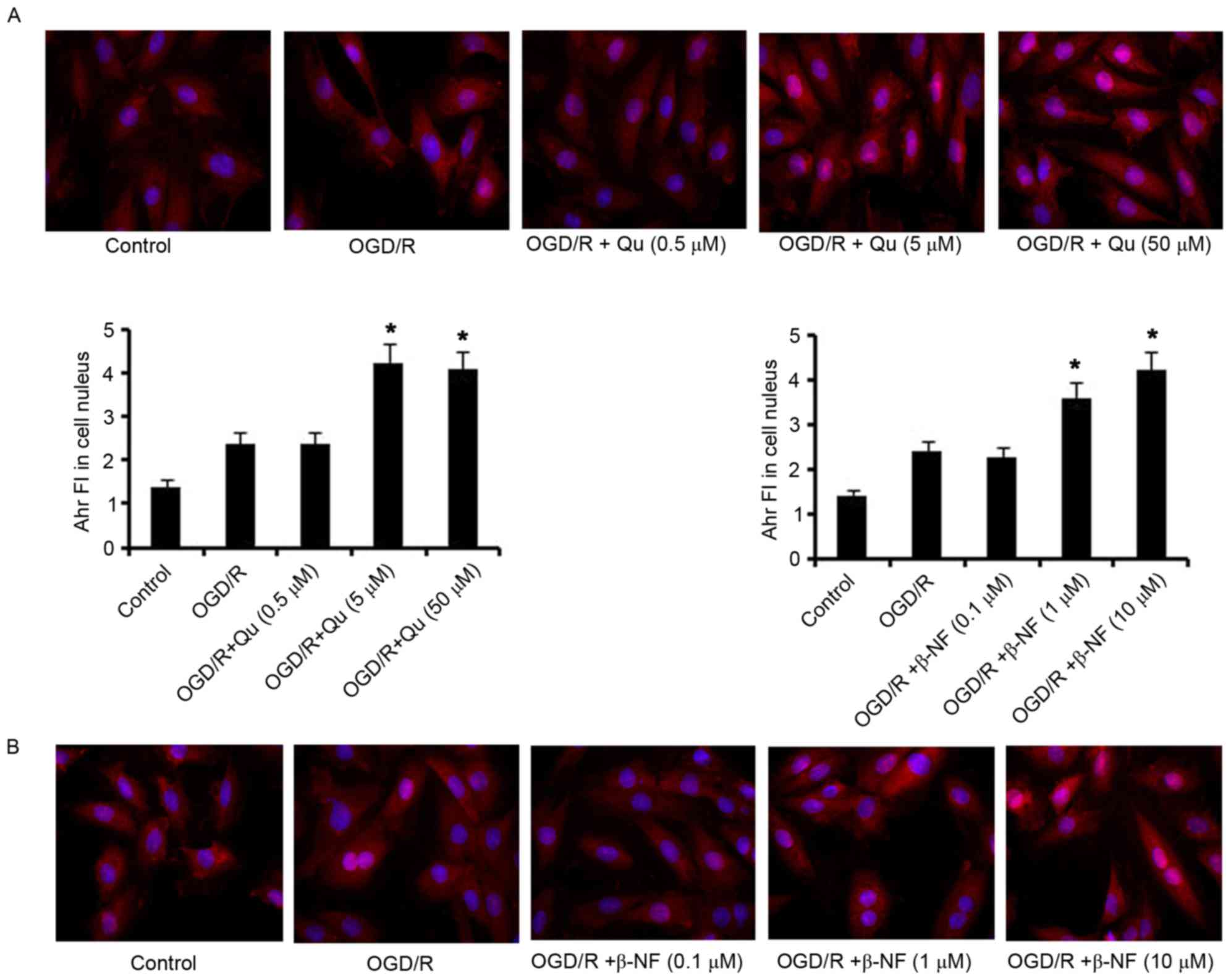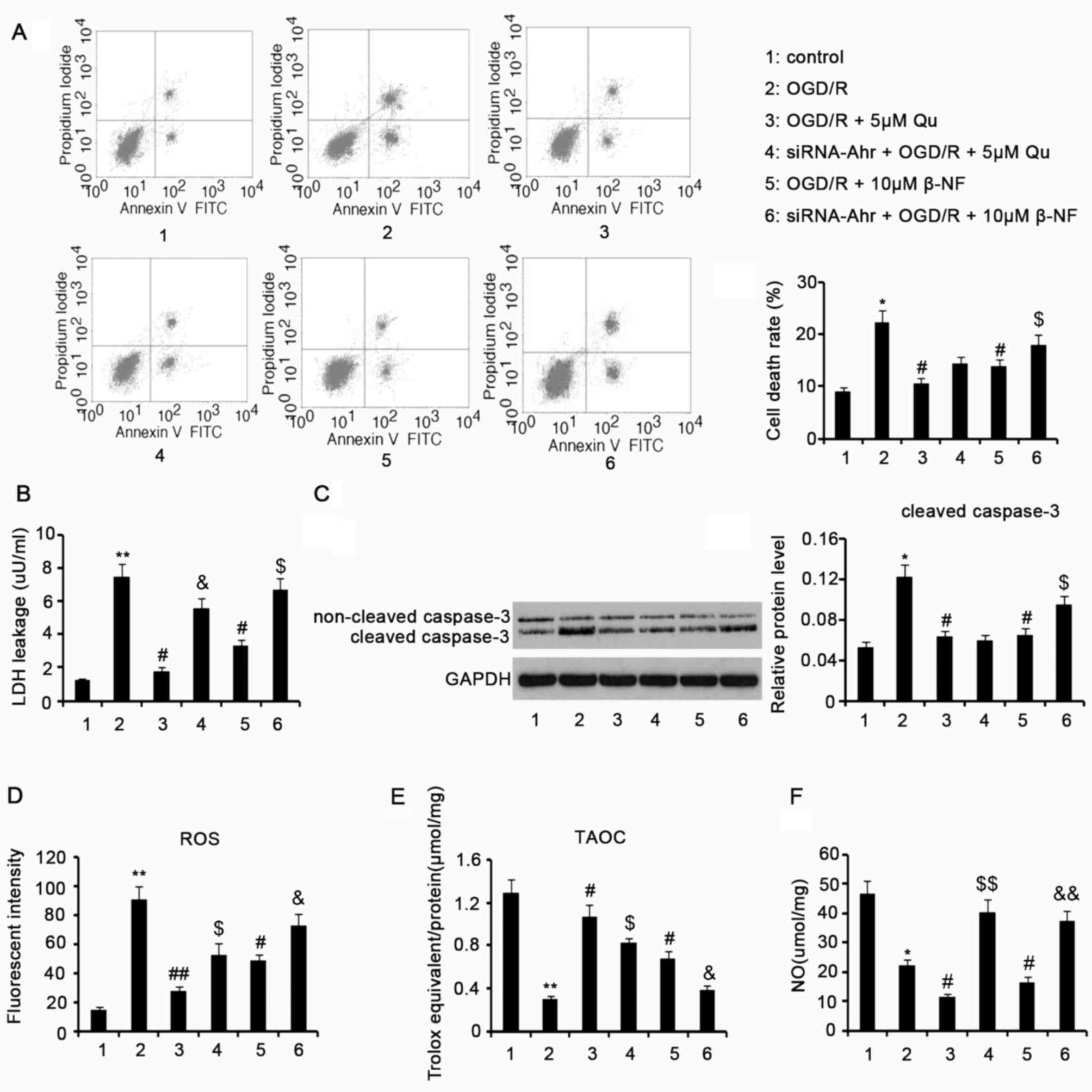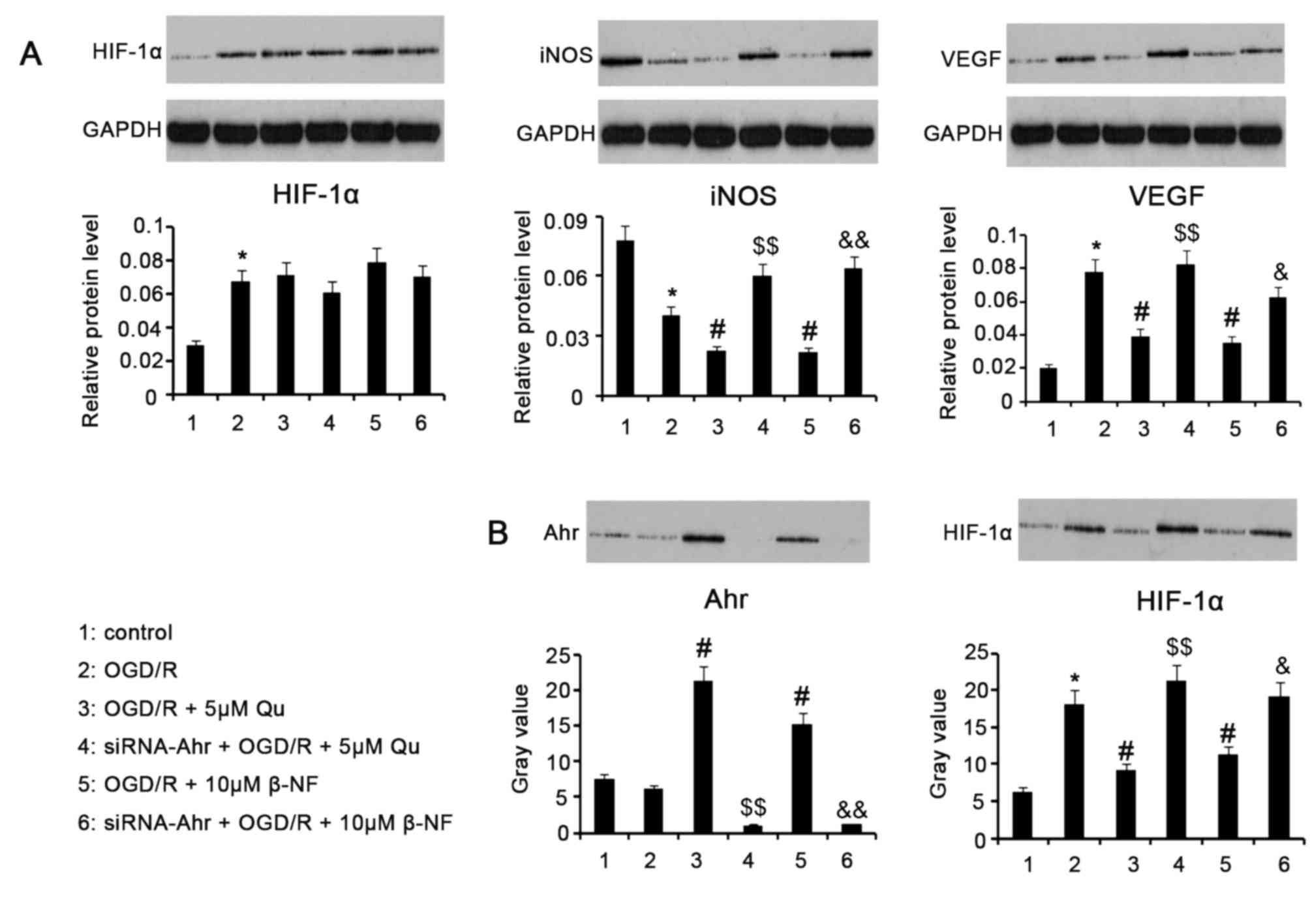|
1
|
Wu WY, Wang WY, Ma YL, Yan H, Wang XB, Qin
YL, Su M, Chen T and Wang YP: Sodium tanshinone IIA silate inhibits
oxygen-glucose deprivation/recovery-induced cardiomyocyte apoptosis
via suppression of the NF-κB/TNF-α pathway. Br J Pharmacol.
169:1058–1071. 2013. View Article : Google Scholar : PubMed/NCBI
|
|
2
|
Zhao D, Li Q, Huang Q, Li X, Yin M, Wang Z
and Hong J: Cardioprotective effect of propofol against oxygen
glucose deprivation and reperfusion injury in H9c2 cells. Oxid Med
Cell Longev. 2015:1849382015. View Article : Google Scholar : PubMed/NCBI
|
|
3
|
Zhou T, Chuang CC and Zuo L: Molecular
characterization of reactive oxygen species in myocardial
ischemia-reperfusion injury. Biomed Res Int. 2015:8649462015.
View Article : Google Scholar : PubMed/NCBI
|
|
4
|
Chen JY, Hu RY and Chou HC:
Quercetin-induced cardioprotection against doxorubicin
cytotoxicity. J Biomed Sci. 20:952013. View Article : Google Scholar : PubMed/NCBI
|
|
5
|
Wang Y, Zhang ZZ, Wu Y, Ke JJ, He XH and
Wang YL: Quercetin postconditioning attenuates myocardial
ischemia/reperfusion injury in rats through the PI3K/Akt pathway.
Braz J Med Biol Res. 46:861–867. 2013. View Article : Google Scholar : PubMed/NCBI
|
|
6
|
Dong Q, Chen L, Lu Q, Sharma S, Li L,
Morimoto S and Wang G: Quercetin attenuates doxorubicin
cardiotoxicity by modulating Bmi-1 expression. Br J Pharmacol.
171:4440–4454. 2014. View Article : Google Scholar : PubMed/NCBI
|
|
7
|
Ozbek N, Bali EB and Karasu C: Quercetin
and hydroxytyrosol attenuates xanthine/xanthine oxidase-induced
toxicity in H9c2 cardiomyocytes by regulation of oxidative stress
and stress-sensitive signaling pathways. Gen Physiol Biophys.
34:407–414. 2015.PubMed/NCBI
|
|
8
|
Agrawal YO, Sharma PK, Shrivastava B, Ojha
S, Upadhya HM, Arya DS and Goyal SN: Hesperidin produces
cardioprotective activity via PPAR-γ pathway in ischemic heart
disease model in diabetic rats. PLoS One. 9:e1112122014. View Article : Google Scholar : PubMed/NCBI
|
|
9
|
Nannelli A, Rossignolo F, Tolando R,
Rossato P, Longo V and Gervasi PG: Effect of beta-naphthoflavone on
AhR-regulated genes (CYP1A1, 1A2, 1B1, 2S1, Nrf2, and GST) and
antioxidant enzymes in various brain regions of pig. Toxicology.
265:69–79. 2009. View Article : Google Scholar : PubMed/NCBI
|
|
10
|
Morrissy S, Strom J, Purdom-Dickinson S
and Chen QM: NAD (P)H:quinone oxidoreductase 1 is induced by
progesterone in cardiomyocytes. Cardiovasc Toxicol. 12:108–114.
2012. View Article : Google Scholar : PubMed/NCBI
|
|
11
|
Higgins LG and Hayes JD: Mechanisms of
induction of cytosolic and microsomal glutathione transferase (GST)
genes by xenobiotics and pro-inflammatory agents. Drug Metab Rev.
43:92–137. 2011. View Article : Google Scholar : PubMed/NCBI
|
|
12
|
Reed JR, Cawley GF and Backes WL:
Inhibition of cytochrome P450 1A2-mediated metabolism and
production of reactive oxygen species by heme oxygenase-1 in rat
liver microsomes. Drug Metab Lett. 5:6–16. 2011. View Article : Google Scholar : PubMed/NCBI
|
|
13
|
Daubney J, Bonner PL, Hargreaves AJ and
Dickenson JM: Cardioprotective and cardiotoxic effects of quercetin
and two of its in vivo metabolites on differentiated h9c2
cardiomyocytes. Basic Clin Pharmacol Toxicol. 116:96–109. 2015.
View Article : Google Scholar : PubMed/NCBI
|
|
14
|
Zordoky BN and El-Kadi AO:
2,3,7,8-Tetrachlorodibenzo-p-dioxin and beta-naphthoflavone induce
cellular hypertrophy in H9c2 cells by an aryl hydrocarbon
receptor-dependant mechanism. Toxicol In Vitro. 24:863–871. 2010.
View Article : Google Scholar : PubMed/NCBI
|
|
15
|
Vrba J, Kren V, Vacek J, Papouskova B and
Ulrichova J: Quercetin, quercetin glycosides and taxifolin differ
in their ability to induce AhR activation and CYP1A1 expression in
HepG2 cells. Phytother Res. 26:1746–1752. 2012. View Article : Google Scholar : PubMed/NCBI
|
|
16
|
Smith KJ, Murray IA, Tanos R, Tellew J,
Boitano AE, Bisson WH, Kolluri SK, Cooke MP and Perdew GH:
Identification of a high-affinity ligand that exhibits complete
aryl hydrocarbon receptor antagonism. J Pharmacol Exp Ther.
338:318–327. 2011. View Article : Google Scholar : PubMed/NCBI
|
|
17
|
Narayanan GA, Murray IA, Krishnegowda G,
Amin S and Perdew GH: Selective aryl hydrocarbon receptor
modulator-mediated repression of CD55 expression induced by
cytokine exposure. J Pharmacol Exp Ther. 342:345–355. 2012.
View Article : Google Scholar : PubMed/NCBI
|
|
18
|
Tsai CH, Li CH, Liao PL, Cheng YW, Lin CH,
Huang SH and Kang JJ: NcoA2-dependent inhibition of HIF-1α
activation is regulated via AhR. Toxicol Sci. 48:17–30. 2015.
|
|
19
|
Ong SG and Hausenloy DJ: Hypoxia-inducible
factor as a therapeutic target for cardioprotection. Pharmacol
Ther. 136:69–81. 2012. View Article : Google Scholar : PubMed/NCBI
|
|
20
|
Adluri RS, Thirunavukkarasu M, Dunna NR,
Zhan L, Oriowo B, Takeda K, Sanchez JA, Otani H, Maulik G, Fong GH
and Maulik N: Disruption of hypoxia-inducible transcription
factor-prolyl hydroxylase domain-1 (PHD-1-/-) attenuates ex vivo
myocardial ischemia/reperfusion injury through hypoxia-inducible
factor-1α transcription factor and its target genes in mice.
Antioxid Redox Signal. 15:1789–1797. 2011. View Article : Google Scholar : PubMed/NCBI
|
|
21
|
Bandarra D, Biddlestone J, Mudie S, Müller
HA and Rocha S: HIF-1α restricts NF-κB-dependent gene expression to
control innate immunity signals. Dis Model Mech. 8:169–181. 2015.
View Article : Google Scholar : PubMed/NCBI
|
|
22
|
Poynter JA, Manukyan MC, Wang Y, Brewster
BD, Herrmann JL, Weil BR, Abarbanell AM and Meldrum DR: Systemic
pretreatment with dimethyloxalylglycine increases myocardial HIF-1α
and VEGF production and improves functional recovery after acute
ischemia/reperfusion. Surgery. 150:278–283. 2011. View Article : Google Scholar : PubMed/NCBI
|
|
23
|
Siu KL, Lotz C, Ping P and Cai H: Netrin-1
abrogates ischemia/reperfusion-induced cardiac mitochondrial
dysfunction via nitric oxide-dependent attenuation of NOX4
activation and recoupling of NOS. J Mol Cell Cardiol. 78:174–185.
2015. View Article : Google Scholar : PubMed/NCBI
|
|
24
|
Alánová P, Kolář F, Ošťádal B and Neckář
J: Role of NO/cGMP signaling pathway in cardiac ischemic tolerance
of chronically hypoxic rats. Physiol Res. 64:783–787.
2015.PubMed/NCBI
|
|
25
|
Totzeck M, Hendgen-Cotta U and Rassaf T:
Concepts of hypoxic NO signaling in remote ischemic
preconditioning. World J Cardiol. 7:645–651. 2015. View Article : Google Scholar : PubMed/NCBI
|
|
26
|
Bir SC, Pattillo CB, Pardue S, Kolluru GK,
Shen X, Giordano T and Kevil CG: Nitrite anion therapy protects
against chronic ischemic tissue injury in db/db diabetic mice in a
NO/VEGF-dependent manner. Diabetes. 63:270–281. 2014. View Article : Google Scholar : PubMed/NCBI
|

















